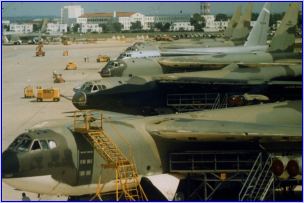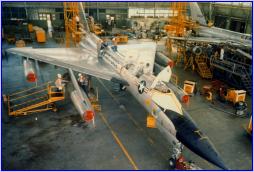|
In the early '50s, propeller whine was replaced by jet roar. Boeing B-47s, first operational all jet strategic bombers, began to line Kelly ramps awaiting their turn to pass through the overhaul and modification lines in building 375, at that time the world’s largest hangar.  They would be followed by a succession of aerial armament including the B-58 Hustler, the F-102 Delta Dagger, and now the venerable B-52 Stratofortress. For over forty-five years the B-52 filled the role of manned strategic bombers; and for thirty-six of those years, the San Antonio Air Materiel Area and its successor, the San Antonio Air Logistics Center, strengthened its airframe and modified its offensive and defensive capabilities. In January 1970, a cavern with wings shared the maintenance area with the camouflaged B-52s. It is the world’s largest aircraft, the Lockheed C-5. This enormous cargo and troop carrier, longer than the area covered by the Wright brothers’ first flight, was the most ambitious workload ever assumed by this or any other Air Logistics Center. From the tip of its liftable nose, to the top of its five-story tail, the C-5 was a Kelly management responsibility for over 35 years. Less visible was the vital support given to other aircraft and weapon systems. Kelly personnel managed over half of the Air Force engine inventory, repairing and managing the C-5's TF39 engine and the F100 engine, which powers the F-15 and F-16 aircraft. Kelly personnel also managed engines for the T-37 and T-38 trainers, the A-10 Attack aircraft and C-130 transport. Other members of the Kelly team manage all the fuel used by the Air Force and NASA and monitor all Air Force nuclear weaponry. They would be followed by a succession of aerial armament including the B-58 Hustler, the F-102 Delta Dagger, and now the venerable B-52 Stratofortress. For over forty-five years the B-52 filled the role of manned strategic bombers; and for thirty-six of those years, the San Antonio Air Materiel Area and its successor, the San Antonio Air Logistics Center, strengthened its airframe and modified its offensive and defensive capabilities. In January 1970, a cavern with wings shared the maintenance area with the camouflaged B-52s. It is the world’s largest aircraft, the Lockheed C-5. This enormous cargo and troop carrier, longer than the area covered by the Wright brothers’ first flight, was the most ambitious workload ever assumed by this or any other Air Logistics Center. From the tip of its liftable nose, to the top of its five-story tail, the C-5 was a Kelly management responsibility for over 35 years. Less visible was the vital support given to other aircraft and weapon systems. Kelly personnel managed over half of the Air Force engine inventory, repairing and managing the C-5's TF39 engine and the F100 engine, which powers the F-15 and F-16 aircraft. Kelly personnel also managed engines for the T-37 and T-38 trainers, the A-10 Attack aircraft and C-130 transport. Other members of the Kelly team manage all the fuel used by the Air Force and NASA and monitor all Air Force nuclear weaponry.

Although the Berlin Wall came down in 1989, Kelly AFB remained a vital part of American defense of freedom. During Operation JUST CAUSE in December 1989, Kelly was a staging area for troops on their way to Panama and was a reception point for wounded Americans. Less than a year later Kelly’s people worked 24-hour days in support of American and Allied efforts to drive Iraqi invaders from Kuwait in Operations DESERT SHIELD/DESERT STORM. By March 1991, Kelly had sent nine million pounds of munitions to the theatre of operations along with 7,400 tons of other supplies and 4,700 passengers. In April 1999, Kelly employees again were called upon to perform their "logistical magic." Engines were surged to support NATO's efforts to end brutal ethnic cleansing in Kosovo.
|